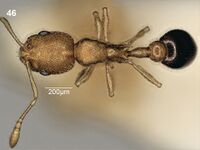Cardiocondyla heinzei
| Cardiocondyla heinzei | |
|---|---|

| |
| Scientific classification | |
| Kingdom: | Animalia |
| Phylum: | Arthropoda |
| Class: | Insecta |
| Order: | Hymenoptera |
| Family: | Formicidae |
| Subfamily: | Myrmicinae |
| Tribe: | Crematogastrini |
| Genus: | Cardiocondyla |
| Species: | C. heinzei |
| Binomial name | |
| Cardiocondyla heinzei Seifert, 2024 | |
This species is only known from the two type localities in Ivory Coast.
Identification
A member of the Cardiocondyla wroughtonii group.
Seifert (2024) - Due to the combination of a large CL/CW and small PeW/CS and FRS/CS, it should not be confused with other members of the C. wroughtonii group.
Distribution
Latitudinal Distribution Pattern
Latitudinal Range: 8.84° to 8.77°.
| North Temperate |
North Subtropical |
Tropical | South Subtropical |
South Temperate |
- Source: Seifert, 2024
Distribution based on Regional Taxon Lists
Afrotropical Region: Ivory Coast (type locality).
Distribution based on AntMaps
Distribution based on AntWeb specimens
Check data from AntWeb
Countries Occupied
| Number of countries occupied by this species based on AntWiki Regional Taxon Lists. In general, fewer countries occupied indicates a narrower range, while more countries indicates a more widespread species. |

|
Estimated Abundance
| Relative abundance based on number of AntMaps records per species (this species within the purple bar). Fewer records (to the left) indicates a less abundant/encountered species while more records (to the right) indicates more abundant/encountered species. |

|
Biology
Seifert (2024) - The workers foraged on the ground in both open and wooded areas.
|
Castes
This species is known only from the worker caste.
Nomenclature
The following information is derived from Barry Bolton's Online Catalogue of the Ants of the World.
- heinzei. Cardiocondyla heinzei Seifert, 2024: 134, figs. 47, 48 (w.) IVORY COAST.
Unless otherwise noted the text for the remainder of this section is reported from the publication that includes the original description.
Type Material
- Cardiocondyla heinzei: Holotype (designated by Seifert, 2024), 1 worker, Comoé National Park Research Station, Ivory Coast, 8°46′13″N 3°47′23″W / 8.7703°N 3.7897°W, 4.iv.2019, Jürgen Heinze, SMNG20240630, SMNG.
- Cardiocondyla heinzei: Paratypes (designated by Seifert, 2024), 3 workers, Comoé National Park Research Station, Ivory Coast, 8°46′13″N 3°47′23″W / 8.7703°N 3.7897°W, 4.iv.2019, Jürgen Heinze, SMNG.
- Cardiocondyla heinzei: Paratypes (designated by Seifert, 2024), 3 workers, Comoé Park, Iringo River, Ivory Coast, 8°50′25″N 3°46′16″W / 8.84028°N 3.77111°W, 6.iv.2019, Jürgen Heinze, SMNG.
- Cardiocondyla heinzei: Paratypes (designated by Seifert, 2024), 2 workers, Comoé National Park Research Station, Ivory Coast, 8°46′13″N 3°47′23″W / 8.7703°N 3.7897°W, 7.iv.2019, Jürgen Heinze, SMNG.
Description
Worker
Extremely small, CS 377 μm. Head elongated, CL/CW 1.189. Median third of anterior clypeal margin slightly concave, median third of occipital margin straight. Postocular distance large, PoOc/CL 0.457. Frons very narrow (FRS/CS 0.219), widening frontad (FL/FR 1.063), caudal of FRS level parallel. Eye without any microsetae and rather smalll, EYE/CS 0.232. Scape moderately long, SL/CS 0.786. Metanotal groove in profile in absolute terms rather deep (MGr/CS 3.25%) but with shallow slopes to mesonotum and propodeum. Prododeal spines long (SP/CS 0.201), thin and acute; in profile deviating from longitudinal mesosomal axis by only 25°, in dorsal view slightly diverging and and slightly incurved; their bases narrow (SPBA/CS 0.240). Petiole very narrow and moderately high (PeW/CS 0.234, PeH/CS 0.333); in lateral view with a concave anterior face and a long weakly convex dorsal profile; petiole in dorsal view very slender, its node 1.5 fold as long as wide and narrowing frontad. Postpetiole rather wide and low (PpW/CS 0.454, PpH/CS 0.276); the sternite anterolaterally with a rounded lobiform protrusion on each side which clearly elevates above the level of median surface of sternite; the surface of the sternite thus appearing deeply concave in frontal view. Postpetiole in dorsal view with a concave anterior margin and convex sides. Anterior clypeus with fine transverse rugulae. Vertex with densely-arranged, flat-bottomed and moderately large foveolae (dFov 16.7). The largest foveolae show a flat tubercle around the hair base of 6–8 μm diameter which is sometimes connected with the outer ring through 1–2 fine microcarinulae. Whole lateral area of mesosoma microreticulate, promesontum foveolate- reticulate. Petiole microreticulate, postpetiole more shiny. First gaster tergite with a rather long and dense pubescence (PLG/CS 7.12%, sqPDG 4.14) and a weak microreticulum (Fig. 48). All body parts yellowish with exception of the blackish brown gaster.
Etymology
The name is given in honor of Jürgen Heinze who has done and supervised outstanding research on the fascinating biology of Cardiocondyla ants over three decades.

